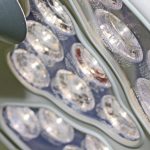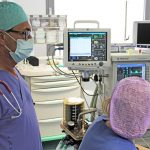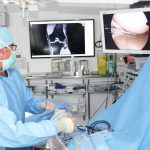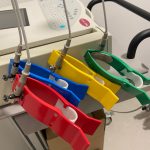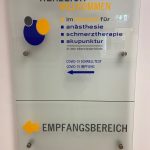LASER CENTRE
In order to be able to carry out a particularly effective and professional laser treatment of a wide variety of structures, a large number of special lasers are required. Our clinics have 28 laser systems, our special lasers are suitable for the optimal treatment of:
WINE MARKINGS
Port-wine stainThe port-wine stain, nevus flammeus, is a benign, congenital or early childhood malformation of the capillaries, i.e. the small vessels of the skin. Without therapy, the malformation, which can occur anywhere in the body, remains lifelong. Sometimes, in about 5% of cases, a port-wine stain is a partial symptom of another disease and in these cases often occurs in parallel with malformations of larger vessels or other tissues, such as e.g. B. the bone or the adipose tissue. The symptoms of port-wine stains – light red to blue-red color changes in the skin that disappear when pressure is applied – usually appear at birth, in rare cases only after a few days. A distinction is made between a symmetrical and an asymmetrical form. The symmetrical port-wine stain occurs mainly in a lesser form in 30-50% of all children. At birth, it sits at the so-called embryonic closure points, e.g. B. the nostrils, the upper eyelids or in the sacrum area. Known special forms are the so-called salmon spot in the middle of the forehead and the so-called stork bite in the neck. The asymmetrical port-wine stain, on the other hand, occurs in less than 1% of newborns and ranges in size from a few millimeters to entire parts of the body. It can appear anywhere on the body and, if left untreated, grows throughout life in proportion to human height growth.
Birthmark: causes
The causes or the hereditary basis of port wine stains are unclear and probably to be regarded as a „freak of nature“. Rumored theories that port-wine stains are due to the mother’s lifestyle, e.g. B. tight clothing or shock or grief during pregnancy are unfounded. As a single phenomenon with no other malformations, port-wine stain is not genetically inherited. In the rare cases in which the port-wine stain occurs together with other abnormalities, e.g. B. Sturge-Weber syndrome, the Klippel-Trenaunay-Weber syndrome or the Proteus syndrome, but there is a genetic connection.
Birthmark: Diagnosis
The diagnosis of port-wine stain can be made in the first few months of the child’s life based on the appearance and the course of the color changes in the skin. A removal of tissue from the affected skin areas is usually unnecessary, since the increased content of red blood cells in the vessels, which is typical for port-wine stains, and the increased diameter of the vessels only become apparent with increasing age. In any case, children with unclear reddish skin discolouration should be examined regularly in order to avoid confusing the port-wine stain, e.g. B. with a blood sponge, i.e. a hemangioma, and to be able to initiate treatment of the hemangioma as early as possible if necessary. A hemangioma is an embryonic tumor which, like a port-wine stain, appears as a reddish spot for the first few weeks, but changes rapidly after 4-6 weeks and becomes darker, nodular, and raised.
Birthmark: therapy
A birthmark sometimes affects the self-esteem of an adult, e.g. B. when it occurs in the facial area, as well as living together with the environment. Therefore, early treatment makes sense, preferably in infancy or early childhood. A birthmark can, in addition to conservative measures such. B. a usually quite time-consuming cover with camouflage or make-up, can also be treated invasively with a dye laser. It is treated with a so-called “flashlamp pumped dye laser” (FPDL), which, thanks to its short pulse lengths of 200 to 1500 µs, triggers scar-free welding of the small vessels; Complications are extremely rare. The costs of this medically necessary treatment are covered by health insurance companies.
Our specialist for port wine stain treatment:
Udo Kroeckert
Kastanienallee 18-19
38102 Brunswick
Phone: 0531-707080
info@venenzentrum-bs.de
TATTOO REMOVAL
Our laser systems are able to remove a wide variety of colors – including green, red and yellow. Today, state-of-the-art laser systems are available that enable scar-free tattoo removal.
The active principle is not the removal of the skin, which would inevitably lead to scarring, but the atomization of the color particles of the tattoo ink into extremely small and minute micro-components, which are so small that they can be broken down and excreted by the body’s own cells after the laser therapy without scarring.
WART REMOVAL
Warts are caused by viruses. If these warts are „scraped off“ or removed with a scalpel, bleeding occurs through the surgical incision, which can lead to increased wart formation (hematogenous metastasis).
With laser therapy, the blood vessels are welded first, bleeding is prevented, thus excluding hematogenous metastasis. As a result, laser wart removal has significant advantages over surgical removal.
COUPEROSE, TELEANGIECTASIA AND SPIDER VEIN
Our special lasers can remove burst veins on the face and other parts of the body without scarring. The principle of action is that the laser light develops significantly more energy in the red-blue color segment than in the skin. This allows us to weld the veins without scarring, without destroying the skin.
In the case of spider veins, we also use the effective laser method in addition to sclerotherapy.
AGE SPOTS
To remove age spots on the face, hands and arms, we have also purchased a special laser that enables painless removal of age spots without anesthesia. In addition, only one session is usually required for removal. The method is perfect and does not lead to light spots under the former age spots, but the normal skin color without pigment shift comes back in the places of the former age spots.
YOUR CONTACT PERSON
for tattoo removal and age spots

















